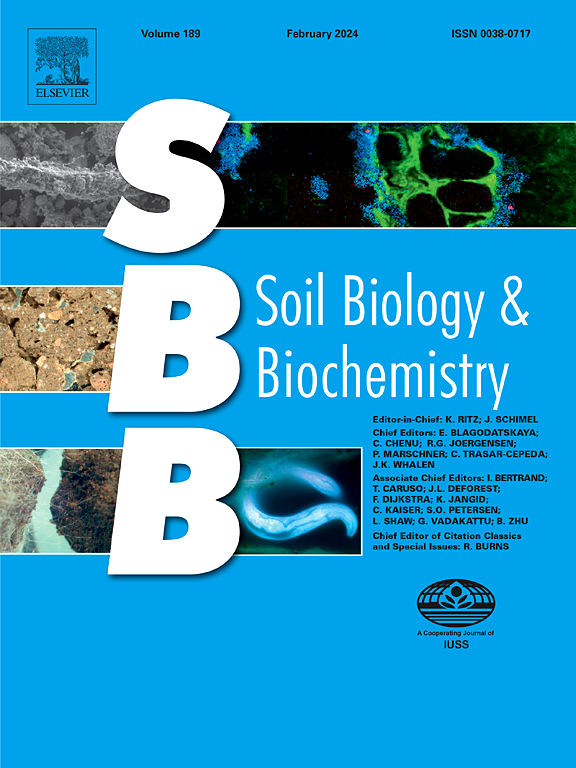Precipitation and diameter affect wood decomposition both directly and indirectly via deadwood traits and position
IF 10.3
1区 农林科学
Q1 SOIL SCIENCE
引用次数: 0
Abstract
Woody plants are important components of dryland ecosystems. Our understanding of wood decomposition in drylands, an important component of biogeochemical cycling, is poor compared to that in mesic ecosystems. To uncovering the complex interactive effects of the different key drivers, we studied the effects of precipitation, position (aboveground and belowground), wood size and litter quality of plant species (four to five local species and one widespread woody species) on woody litter decomposition rates along a precipitation gradient from 37 to 369 mm, spanning five dryland sites. Wood dry matter content (DMC) was a critical negative predictor of wood decomposition in water-limited ecosystems. Thicker woody litter had lower decomposition rates (k values) directly because of smaller relative surface exposure, and indirectly through higher wood DMC or lower bark mass ratio (bark mass divided by wood mass for a given branch length). Mean annual precipitation (MAP) increased the k values both directly, and indirectly by decreasing the wood DMC and increasing the bark mass ratio due to species turnover. The k values of buried woody litter were mostly two to three times higher than litter on the soil surface, but not different at the extremely arid site. A steeper slope of the relationship between overall woody litter quality (particularly wood DMC) or annual precipitation and k values was observed belowground than aboveground, as related to the higher moisture belowground than aboveground. These findings highlight the complex interactions among climate (precipitation), litter position, size and quality on wood decomposition in drylands, thereby helping to improve our mechanistic understanding of dryland woody litter decomposition. We conclude that wood decomposition at the regional and local scales will influence biogeochemical cycling in drylands under future climate change through both direct effects of moisture and indirect effects of litter quality characteristics.
降水量和直径会直接影响木材的分解,也会通过枯木的特性和位置间接影响木材的分解
木本植物是旱地生态系统的重要组成部分。作为生物地球化学循环的一个重要组成部分,我们对旱地木材分解的了解还不如中生生态系统。为了揭示不同关键驱动因素之间复杂的交互作用,我们沿着从 37 毫米到 369 毫米的降水梯度研究了降水、植物物种(四到五个本地物种和一个广布的木本物种)的位置(地上和地下)、木材大小和枯落物质量对木质枯落物分解率的影响。在水分有限的生态系统中,木材干物质含量(DMC)是木材分解的一个关键负预测因子。较厚的枯落物分解率(k 值)较低,直接原因是相对表面暴露较小,间接原因是木材干物质含量较高或树皮质量比(给定树枝长度下树皮质量除以木材质量)较低。年平均降水量(MAP)会直接增加 k 值,也会因物种更替而降低木材 DMC 或增加树皮质量比,从而间接增加 k 值。埋藏在地下的木质废弃物的 k 值大多比土壤表面的废弃物高出 2 到 3 倍,但在极度干旱的地点并无差异。地下木质废弃物总体质量(尤其是木质 DMC)或年降水量与 k 值之间的关系斜率陡于地上,这与地下湿度高于地上有关。这些发现凸显了气候(降水)、枯落物位置、大小和质量对旱地木材分解的复杂相互作用,从而有助于提高我们对旱地木质枯落物分解机理的认识。我们的结论是,在未来气候变化下,区域和地方尺度上的木材分解将通过水分的直接影响和枯落物质量特征的间接影响来影响旱地的生物地球化学循环。
本文章由计算机程序翻译,如有差异,请以英文原文为准。
求助全文
约1分钟内获得全文
求助全文
来源期刊

Soil Biology & Biochemistry
农林科学-土壤科学
CiteScore
16.90
自引率
9.30%
发文量
312
审稿时长
49 days
期刊介绍:
Soil Biology & Biochemistry publishes original research articles of international significance focusing on biological processes in soil and their applications to soil and environmental quality. Major topics include the ecology and biochemical processes of soil organisms, their effects on the environment, and interactions with plants. The journal also welcomes state-of-the-art reviews and discussions on contemporary research in soil biology and biochemistry.
 求助内容:
求助内容: 应助结果提醒方式:
应助结果提醒方式:


